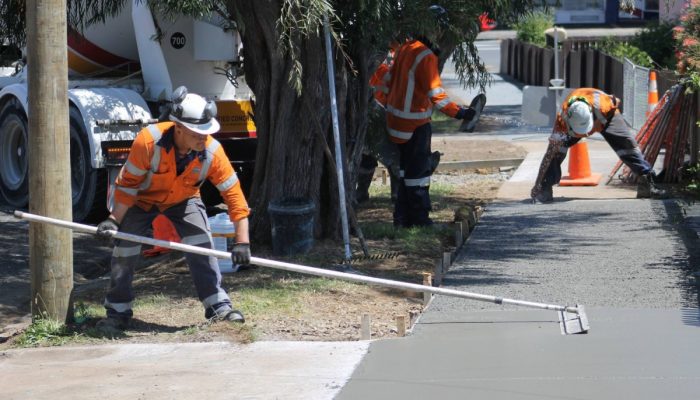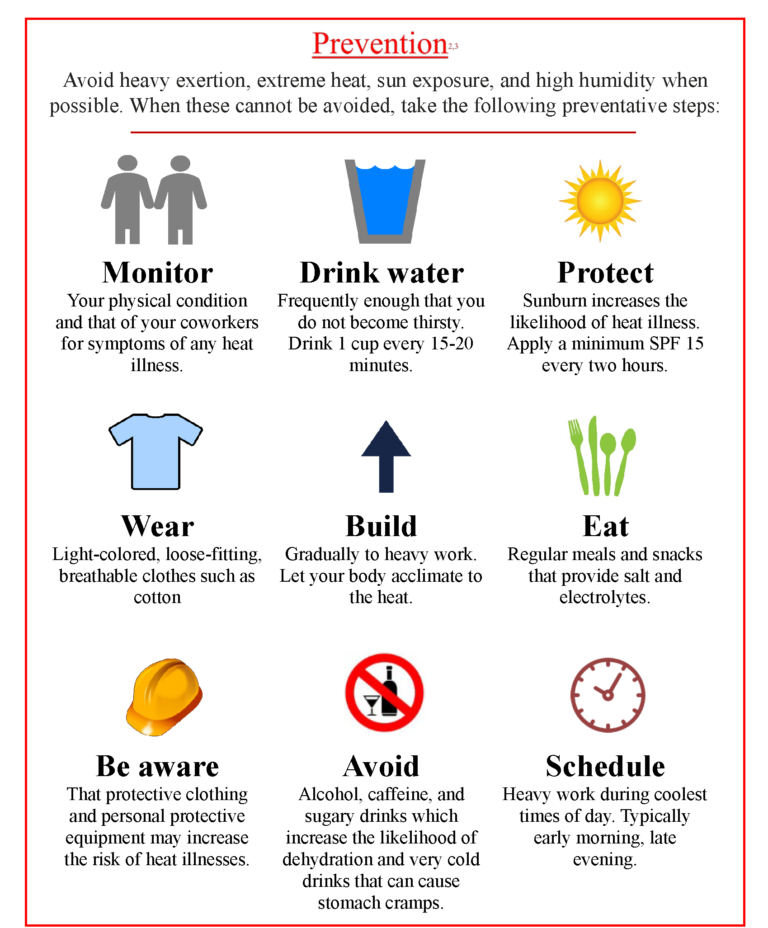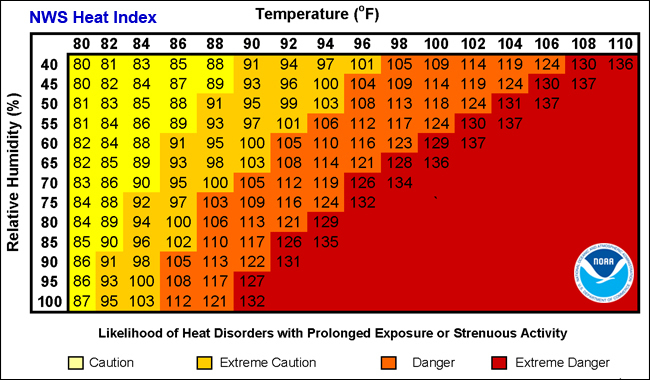Every year, the last Friday of May is recognized at National Heat Awareness Day, which is today! With the weather improving, exterior renovations and projects can begin full force. However, that doesn’t mean that weather hazards are not present. While freezing temperatures can cause frostbite, hypothermia, and other physical hinderances, so can the other end of the spectrum – extreme heat.
Heat stress is the combination of a worker’s exposure to heat from physical activity, environmental factors, and their choice in clothing. These decisions are imperative as they decide on how much heat emits from the body and how much is stored, which is known as the net heat load. One’s core body temperature must remain within 1.8 degrees Fahrenheit (1 degree Celsius) of the normal temperature, 98.6 F or 37C, to function normally. There are many factors that play into our body temperature and causes for fluctuation such as clothing, speed and temperature of air blowing across our body, hydration, skin temperature, etc. If a person is to endure heat-related-injuries (HRI’s), they could experience heat stroke, fainting, cramps, and rashes. Heat stroke is dangerous as it can occur in two forms, classic and exertional. Both occur in hot environments; however, exertional heat stroke can occur in the winter when a worker is wearing many clothes that limit the body’s ability to dissipate heat, with sweating being a beginning sign of potential exertional heat stroke.
With construction workers largely working outdoors, heat stroke is a prominent safety hazard. Depending on the work to be performed, workers may be required to wear clothing that covers skin that has potential to be harmed during construction. For example, asbestos and asphalt workers are at high risk of heat stroke, especially during the warmer months of the year, or warmer climates of the world. Asbestos workers are required to wear full protective gear when dealing with asbestos cases. This includes full body suit that covers legs, arms, and head, foot covers, head cover, goggles, a respirator, and other gear necessary. This level of protection is necessary as asbestos is extremely dangerous to encounter, however, makes the job very difficult; especially if the air is off due to HVAC renovations. For asphalt workers, they are also required to wear long pants, long sleeve shirts, goggles, gloves, and respirators in certain circumstances. As we mentioned in our previous blog, asphalt fumes are highly toxic to workers, and if a splatter were to occur, the asphalt would burn through you immediately. When the asphalt is being mixed, it stands between 275 and 300 degrees Fahrenheit, which is almost equal to the temperature of Mercury! The asphalt must remain between 220 – 290 degrees Fahrenheit to be rolled, or else it will become to stiff to smooth out, which makes hot summer days perfect for this trade as the ground and air are both warm enough to help the work be performed correctly.
There are many ways to identify heat-related illnesses and ways to combat them. Heat stroke is the most serious to experience, and can be identified by symptoms of confusion, slurred speech, loss of consciousness, hot/dry skin or profuse sweating, and/or seizures, and could result in death if not treated immediately. If you become aware of someone experiencing heat stroke, call 911 immediately and move them to a shaded and cool area. If possible, immerse them immediately into an ice bath or cold water, otherwise place ice or cold-water bottles on their main artery points – wrists, neck, head, ankles, armpits, and groin. For heat exhaustion, you’d do these same first-aid procedures but less extreme. Have the person remove any unnecessary clothing and give them small sips of liquids. Although they may be coherent, it’s highly advised to seek medical attention as it could become more serious. Overall, HRI’s have many of the same symptoms – light headedness/dizziness, cramping, weakness, and others. However, they can all be simultaneously avoided by doing a few simple things.

1. Drink Enough Water
On average, one should be drinking at least 64 ounces of water a day. However, when working in the sun, that amount should be drank every 2 hours, meaning a worker should be drinking almost 2 gallons a day. However, don’t overdo it! Drinking too much water all at once has its own side effects that could cause a different medical emergency. It’s recommended to drink 1 cup of water every 15-20 minutes.
2. Change Your Clothing
While many trades don’t have this choice, wearing looser clothing can allow more air flow and escapes for body heat. However, too loose can pose a risk of other hazards, such as being caught or pulled. Lighter clothing also helps reflect heat, whereas darker colors absorb. Try opting for lighter colored shirts that reflect the sun but also allow for high visibility on sites. Another way to remain safe is to bring extra clothes! If your shirt becomes heavy with sweat or dirt, you should change your shirt to allow air flow back, as well as prevent raising your skin temperature any further.
3. Sunscreen
While the farmer’s tan is a look, it’s also proof of how harmful the sun can be. By wearing sunscreen, you’re allowing your skin to remain protected, as well as avoid raising your skin temperature by drying it out. Sunscreen allows your to keep moisture in while maintaining body heat dissipation. Sunscreen of SPF 30 or higher is recommended and should be applied every 2 hours, as well as 20 minutes before sun exposure.

4. Take More Frequent Breaks
Wearing a hard hat and heavy boots all day can factor into your body retaining heat as those are main points for heat release. When it’s safe to do so, during breaks, take your hard hat and boots off to allow heat to leave your body, as well as fanning your shirt to bring air flow across your skin. If possible, seek an area to relax that is air conditioned, or an area with large air flow.
5. Buddy System
With rising temperatures, having a buddy system can be extremely helpful! One may not want to address issues due to wanting to finish the job as fast as possible, however, quicker movements can lead to HRI’s much faster. By having a buddy system, workers can be accountable for keeping a steady pace of work, while also making sure each other is drinking enough fluids, taking needed breaks, and other ways to avoid an HRI.
Make sure you stay safe this summer, and always be sure to take care of yourself! If you liked this blog post, make sure to share it via the social media icons below. Also, comment other ways one can protect themselves from heat-related illnesses, or ways you help prevent them at your business!
Share this Post


